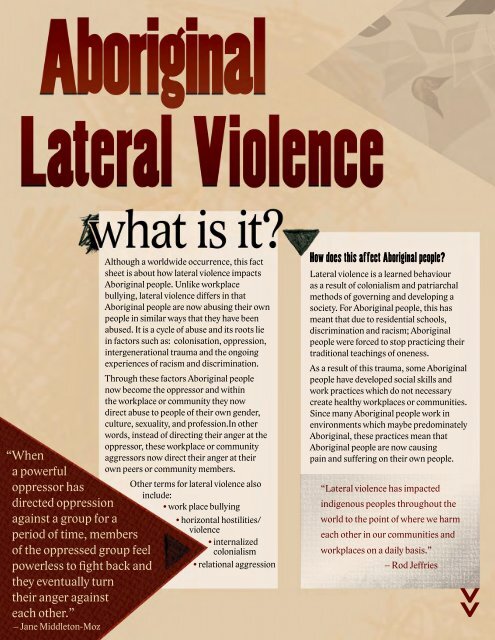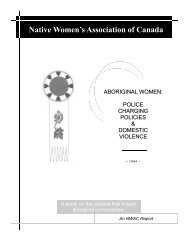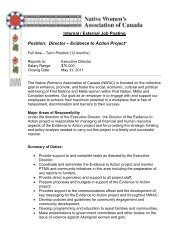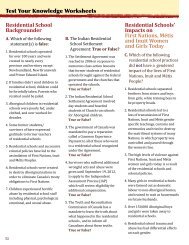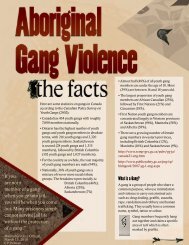Aboriginal Lateral Violence - Native Women's Association of Canada
Aboriginal Lateral Violence - Native Women's Association of Canada
Aboriginal Lateral Violence - Native Women's Association of Canada
You also want an ePaper? Increase the reach of your titles
YUMPU automatically turns print PDFs into web optimized ePapers that Google loves.
“Whena powerfuloppressor hasdirected oppressionagainst a group for aperiod <strong>of</strong> time, members<strong>of</strong> the oppressed group feelpowerless to fight back andthey eventually turntheir anger againsteach other.”– Jane Middleton-MozAlthough a worldwide occurrence, this factsheet is about how lateral violence impacts<strong>Aboriginal</strong> people. Unlike workplacebullying, lateral violence differs in that<strong>Aboriginal</strong> people are now abusing their ownpeople in similar ways that they have beenabused. It is a cycle <strong>of</strong> abuse and its roots liein factors such as: colonisation, oppression,intergenerational trauma and the ongoingexperiences <strong>of</strong> racism and discrimination.Through these factors <strong>Aboriginal</strong> peoplenow become the oppressor and withinthe workplace or community they nowdirect abuse to people <strong>of</strong> their own gender,culture, sexuality, and pr<strong>of</strong>ession.In otherwords, instead <strong>of</strong> directing their anger at theoppressor, these workplace or communityaggressors now direct their anger at theirown peers or community members.Other terms for lateral violence alsoinclude:• work place bullyingHow does this affect <strong>Aboriginal</strong> people?<strong>Lateral</strong> violence is a learned behaviouras a result <strong>of</strong> colonialism and patriarchalmethods <strong>of</strong> governing and developing asociety. For <strong>Aboriginal</strong> people, this hasmeant that due to residential schools,discrimination and racism; <strong>Aboriginal</strong>people were forced to stop practicing theirtraditional teachings <strong>of</strong> oneness.As a result <strong>of</strong> this trauma, some <strong>Aboriginal</strong>people have developed social skills andwork practices which do not necessarycreate healthy workplaces or communities.Since many <strong>Aboriginal</strong> people work inenvironments which maybe predominately<strong>Aboriginal</strong>, these practices mean that<strong>Aboriginal</strong> people are now causingpain and suffering on their own people.“<strong>Lateral</strong> violence has impactedindigenous peoples throughout the• horizontal hostilities/world to the point <strong>of</strong> where we harmviolenceeach other in our communities and• internalizedcolonialismworkplaces on a daily basis.”• relational aggression – Rod Jeffries
Who does <strong>Lateral</strong> <strong>Violence</strong>?• Boss• Supervisor• Co-workers• Friends• Family Members• Peers• Authority Figures• Community MembersWhat are the behaviours linked withlateral violence?<strong>Lateral</strong> violence takes on a number <strong>of</strong>different toxic behaviours, and it is anyaction that is meant to discourage ormake a person feel bad in the workplace.If you are the target <strong>of</strong> lateral violence theconstant barrage <strong>of</strong> negative behaviourscan be likened to harassment and bullying.In its extreme form, lateral violence canbe conscious, deliberate act <strong>of</strong> meannesswith the overall intention to harm, hurtand induce fear in a co-worker. In otherforms <strong>of</strong> lateral violence, the individualperpetrating the negative behaviour maynot be aware <strong>of</strong> the meanness they areexhibiting and they may not be doing theseactions intentionally.The following are some <strong>of</strong> behaviouralindicators that lateral violence may behappening by you, to you or to someoneelse in your workplace.pg. 2 <strong>Aboriginal</strong> <strong>Lateral</strong> <strong>Violence</strong>• nonverbal intimation (raising eyebrows,making faces, eye rolling)• obvious name calling• sarcasm• bickering• whining• blaming• belittling a person’s opinions• yelling or using pr<strong>of</strong>anity• making up and/or exaggeratingscenarios• making snide comments and remarks• making jokes that are <strong>of</strong>fensive byspoken word or email• using put downs• gossiping• rumour mongering• ignoring, excluding or freezingout people• handing over work assignments withunreasonable deadlines or duties thatwill ensure the person will fail• being purposely unavailable to meetwith staff• undermining activities• withholding information or givingthe wrong information purposely• constantly changing work guidelines• blocking requests for a promotion,leave or training• not giving enough work so theindividual will feel useless• refusing to work with someone• backstabbing• complaining to peers and notconfronting the individual• failing to respect privacy• breaking the confidences <strong>of</strong> others• mobbing or ganging up on others
Where does it happen?Although the most common place forlateral violence is in the workplace, itdoes cross the line into the communityand home. The primary workplaces inwhich lateral violence are more prevalentare those with poor organizational systemsor those workplaces that are undergoingchange such as downsizing or merging,or when power is shifting and people feeluncertain.Why does it happen?<strong>Lateral</strong> violence happens whenindividuals who have enduredoppression suppress feelings such as:anger, shame, and rage. Eventually thesefeelings manifest in behaviours suchas: jealousy, resentment, blame, andbitterness; and they are directed towardtheir <strong>Aboriginal</strong> co-workers.As many <strong>of</strong> these people have been victims<strong>of</strong> abuse these behaviours are usually usedto manipulate, dominate, control anddiminish others. Regardless <strong>of</strong> their issues,the behaviour is not appropriate and noone should be the target <strong>of</strong> someone’sunresolved issues.Anyone can be a target <strong>of</strong> lateral violence...It can really be really disheartening ifyou are the target <strong>of</strong> lateral violence inthe workplace. Most people enter intoan <strong>Aboriginal</strong> organization expectingthat in working with their own peoplethey will be supported and encouraged.Instead you find yourself now workingwith the very people who are bringingyou down and making things hard foryou. What did you do wrong? In mostcases, you did absolutely nothing. <strong>Lateral</strong>violence is more about what is wrong withthe aggressors than the receiver <strong>of</strong> theiraggression.
Anyone can be a target <strong>of</strong> lateral violence...(continued)Certain situations and events predisposeone to experiencing lateral violence in theworkplace. Usually individuals who are thetarget <strong>of</strong> lateral violence are:• New employees that may be coming intoan organization during times <strong>of</strong> changeand become a target because otherworkers who may feel vulnerable see thisindividual as a threat to their jobs.• Employees who have received apromotion or advancement and are seenas undeserving by other co-workers.• Younger employees who have moreeducation and training than olderworkers and are seen as a threat.• Members <strong>of</strong> families or friends <strong>of</strong> leaderswho are no longer in power positions.• Employees who are good at their job andpopular with people.The Effects <strong>of</strong> <strong>Lateral</strong> <strong>Violence</strong>On a personal level, depending on theseverity <strong>of</strong> the lateral violence there are alot <strong>of</strong> health problems that can manifest forthe individual being targeted. They couldexperience:• Sleep disorders either not being able tosleep or not wanting to get out <strong>of</strong> bed inthe morning;• Changes in eating habits – either eatingmore or less or differently;• Weight loss or gain;• Moodiness – lack <strong>of</strong> sleep will usuallymean that you won’t be all that happy;• Self-doubt –you question all yourdecisions and abilities;• Decreased self confidence;• Feelings <strong>of</strong> worthlessness;• Forgetfulness;• Chronic anxiety;“When individualsfeel inferior, inadequateand afraid, they take on thequalities <strong>of</strong> the oppressor as away <strong>of</strong> acquiring strength andan illusion <strong>of</strong> power.”– Jane Middleton-Moz• Depression;• Emotional and teary eyed;• Higher absenteeism-not wantingto be at work; and• Weakening immune system – resultingin greater susceptibility to colds, flu andother illness.Because the individual may have noother employment options, as thelateral violence continues or gets worsethe individual may experience moreintense physical and emotional healthdeterioration. Some individuals end upon sick leave and long-term disability.In the extreme, it can end it suicide orviolent death.The costs to the organization<strong>Lateral</strong> violence not only affects theindividual who is experiencing it. It alsoimpacts other people in the organizationand community. Spending time rumourmongeringand gossiping costs theorganization money in terms <strong>of</strong> lack<strong>of</strong> productivity. Additionally, a toxicorganization also creates an atmospherein which there is:• High staff turnover• Loss <strong>of</strong> corporate history• Low morale• Decreased customer service• Increased financial costs• Increased absenteeism• Lack <strong>of</strong> teamwork• Unhealthy competitionpg. 4 <strong>Aboriginal</strong> <strong>Lateral</strong> <strong>Violence</strong>
For the individual:Sometimes it is difficult to do anythingabout the behaviour <strong>of</strong> others. If youfeel that you are being the target <strong>of</strong>inappropriate behaviour you could:• Report the behaviour to the appropriatemanager in your workplace.• Keep a record <strong>of</strong> the negative behaviours.Make notes about the time, date, locationand any witnesses who may have seenthe incidents.• Address your concerns with the aggressorand ask them if they can stop.• Seek help and advice at work or in thecommunity. In the workplace, you mayhave a human resources manager, ormanager who can assist you in resolvingthe situation.• Speak to an Elder.• Seek external advice.• Seek the support <strong>of</strong> friends and family.For the Organization:Before you can create a healthierworkplace you have to first admit thatlateral violence exists. To address theissues associated with lateral violencemanagement could:• Admit that lateral violence exists.• Establish policy and procedures forlateral violence.• Have workshop sessions on lateralviolence.• Establish rules for civil meetings...no one can cut the other <strong>of</strong>f.“Those most at risk <strong>of</strong> lateral violencein its raw physical form are familymembers and, in the main, thevulnerable members <strong>of</strong> the family:old people, women and children.Especially the children.”– Narcua Langton<strong>Native</strong> Women’s <strong>Association</strong> <strong>of</strong> <strong>Canada</strong> (NWAC) pg. 5
Looking for more information?Bearpaw Media Productions -- <strong>Lateral</strong><strong>Violence</strong> VideoThis is a documentary-drama takes a lookat lateral violence in our own Nations,communities, organizations and families.Hosted by Tantoo Cardinal, this <strong>Lateral</strong><strong>Violence</strong> video sheds a new light on an ageold topic – ourselves.www.bearpawmedia.ca/content.php?ID=15&prodid=72A YouTube clip <strong>of</strong> Rod Jefferies’ workshopon lateral violence in Winnipeg.www.youtube.com/watch?v=aOMJ6wynHUU<strong>Native</strong> Women’s<strong>Association</strong> <strong>of</strong> <strong>Canada</strong>1 Nicholas Street,Suite 900Ottawa, OntarioK1N 7B7T: 613-722-3033T: 1-800-461-4043F: 613-722-7687www.nwac.capg. 6 <strong>Aboriginal</strong> <strong>Lateral</strong> <strong>Violence</strong>


